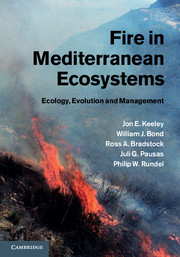4 - Fire in the Mediterranean Basin
from Section II - Regional patterns
Published online by Cambridge University Press: 05 January 2012
Summary
The Mediterranean Basin is a meeting point of three continents, Europe, Asia and Africa, and this is responsible for the great diversity of plants, animals and cultures that formed the cradle of Western civilization. It is considered one of the biodiversity hotspots (Myers et al. 2000) because of its high species richness and high proportion of endemisms (Thompson 2005). The total area showing a mediterranean-type climate (MTC) is about 2.3 million km2, with transitions toward temperate forest ecosystems (in the European mountains) and toward arid ecosystems (in North Africa and the Near East). It is not only the largest of the five MTC regions, but also the most geographically complex (with more than 40 000 km of rough coast in different peninsulas and islands) as well as the most socio-economically, culturally and politically varied. Elevations range up to 3756 m in the east (the highest peak in the Taurus mountains, Turkey) and up to 4167 m in the west (the highest peak in the Atlas mountains, Morocco). There are many volcanoes in Italy and the Aegean Islands, with frequent minor eruptions and rare major explosions. The MTC region of the basin corresponds to a narrow rim around the Mediterranean Sea (Fig. 4.1), and includes: (1) in southern Europe, most of the Iberian peninsula (Portugal and Spain), south of France, most of Italy and Greece, the coast of Croatia, Montenegro and Albania; (2) in southwest Asia (the Near East), Cyprus, Lebanon, Palestine, Israel, most of Turkey, and the coast of Syria; and (3) in North Africa (the Magreb), the north of Tunisia, Algeria, Morocco and small coastal areas of Libya. It also includes all the islands in the Mediterranean Sea.
In general terms, summers are hot and dry and winters are mild and relatively wet; winters may be cold in the interior areas with a continental climate influence (e.g. central Spain and central Turkey). The configuration of seas, peninsulas and islands, and the topographic complexity of the area, produce a great regional variety of weather and climate. Rainfall ranges from semi-arid conditions (<300 mm) up to over 2000 mm, and peaks in autumn and spring (in the west) and in autumn and winter (in the east). Because of the air masses' trajectories, the wettest parts of the basin are typically the western parts of the peninsulas (Iberian, Italian and Balkan peninsulas). There are also clear gradients from the colder and wetter northwest (southern France and northern Iberia) to the hotter and more arid south and southeast parts of the basin (North Africa and the Near East). The temperature-moderating effect of the sea is highest in the west (Atlantic coast) and lessens toward the east (water temperatures rise from west to east).
- Type
- Chapter
- Information
- Fire in Mediterranean EcosystemsEcology, Evolution and Management, pp. 83 - 112Publisher: Cambridge University PressPrint publication year: 2011



